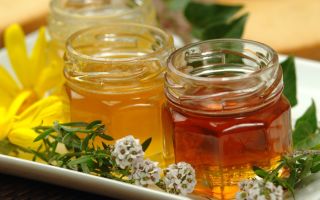Content
- 1 How is chestnut honey obtained?
- 2 Chemical composition and calorie content of chestnut honey
- 3 Why is chestnut honey useful?
- 4 Norms of use and rules of admission
- 5 How to take chestnut honey medicinally
- 6 The use of chestnut honey in cosmetology
- 7 Harm of chestnut honey and contraindications
- 8 How to choose natural chestnut honey
- 9 How to store chestnut honey at home
- 10 Conclusion
- 11 Reviews
The beneficial properties and contraindications of chestnut honey have been known to traditional healers for many centuries, however, ordinary people are more familiar with the healing qualities of this product. The main source of raw materials is two types of chestnuts - Noble and Horse, which cannot be eaten raw. Both varieties differ greatly in taste and appearance, which is often the reason for confusion when trying to determine the authenticity of chestnut honey.
How is chestnut honey obtained?
Chestnut Noble (also Real, Sowing or Sweet) is a productive honey plant, from the flowers of which bees collect the bulk of raw materials in the spring. The variety blooms for just over 2 weeks in late May - early June. A feature of the Noble Chestnut is the unusual color of the flowers - their petals are covered with yellow spots, which eventually turn into a reddish-orange hue. The change in color is accompanied by a change in smell, which serves as a kind of signal for bees about the presence of nectar in flowers.
Honey from Noble Chestnut has a dark color and a bitter taste. It crystallizes slowly and is sold in liquid form even in winter. The product made from Horse Chestnut looks completely different - it is light and almost transparent, liquid and quickly sugar-coated. The value of this type of chestnut honey is lower than that of a product based on noble chestnut nectar.
Chemical composition and calorie content of chestnut honey
The chestnut variety differs from other varieties in its high sucrose content. In addition, the product contains many other useful substances, namely:
- fructose;
- B vitamins (thiamine, riboflavin, folate, pyridoxine), D;
- PP (nicotinic acid);
- acetophenone and aminoacetophenone;
- amino acids;
- enzymes;
- C (ascorbic acid);
- iron;
- sodium;
- potassium;
- phosphorus;
- copper;
- calcium;
- magnesium;
- zinc;
- iodine;
- manganese;
- fluorine.
The energy value of 100 g of the product reaches 284 kcal.
Why is chestnut honey useful?
Chestnut honey is widely used in folk medicine, which is explained by the extensive list of its beneficial properties. The benefits of chestnut honey for the human body is that it:
- relieves puffiness;
- acts as a prophylactic agent for diseases of the genitourinary system;
- facilitates the course of colds;
- heals external skin damage;
- is a natural antiseptic;
- helps with stress and chronic fatigue, providing a tonic effect on the human nervous system;
- improves immunity by activating the protective functions of the body;
- neutralizes stagnation of bile in the liver;
- normalizes the digestive tract due to low acidity and rapid digestibility;
- reduces the risk of developing diseases of the cardiovascular system by strengthening the walls of the capillaries;
- helps with insomnia;
- improves venous and arterial circulation;
- increases appetite;
- improves blood composition;
- stimulates the gallbladder.
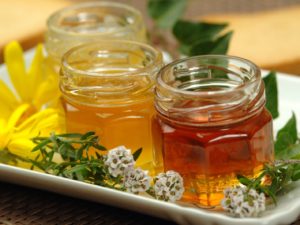
The beneficial properties also include the absence of addiction during treatment with this product - it has no time limit for ingestion. Moreover, in moderation, chestnut honey is approved for consumption by people with diabetes. Overuse of the product in this case can cause serious harm to health, but small doses will benefit from the high fructose content.
With chronic fatigue and rapid fatigue, it is recommended to take about 50 g of chestnut honey daily - 1 tbsp. l. in the morning and the same in the evening. This amount reduces the tension of the human nervous system and promotes rapid falling asleep.
For women
The benefits of chestnut honey for women are primarily cosmetic in nature - due to its rich vitamin composition, it quickly saturates the skin with oxygen, making it silky and fresh. The list of useful properties of chestnut honey for women is not limited to this. In particular, it has the following effects on the female body:
- stimulates metabolism;
- strengthens the body during menopause;
- normalizes hormones.
For men
The benefits of chestnut honey for men lie in its medicinal properties in the treatment of problems of the genitourinary system:
- daily moderate consumption of the product increases potency;
- improves blood circulation;
- relieves inflammation of the prostate gland;
- promotes the treatment of diseases of the urethra.
Among the beneficial properties of chestnut honey for men is also the preventive effect that it has on the human body - regular consumption of the substance minimizes the risk of developing prostatitis.
For children
Among the many medicinal properties of chestnut honey, one can be distinguished, which is especially useful for children - appetite stimulation. It is recommended to give chestnut honey in moderate doses to children who do not eat well.
Norms of use and rules of admission
Despite the fact that chestnut honey has a lot of beneficial properties, it can also be harmful. Doctors recommend to consume about 100-150 g of the substance daily, no more. The optimal daily allowance for children is about 40-50 g (1-2 tablespoons per day).
In order to fully reveal the medicinal properties of the product and minimize the possible harm from it, you should adhere to a number of rules for using chestnut honey:
- Alcohol should be avoided during intensive treatment, otherwise the effect of antioxidants contained in the product will be minimal.
- Short-term courses and one-time consumption of the substance do not have a special effect on the human body. Only long courses of treatment, from 2-3 months to six months, will bring benefit.
- The benefits of the product are increased when combined with royal jelly, propolis and pollen.
- It is recommended to give up cigarettes or at least reduce the amount of nicotine consumed.
- Chestnut honey partially loses its medicinal properties when heated, so it is better not to add it to too hot tea.

How to take chestnut honey medicinally
There are many ways to consume chestnut honey. You can eat it in its original form for 1 tbsp. l. at one time in the morning and in the evening. Sometimes it is diluted in a warm (but not hot) liquid such as tea or water. The most popular way to use is as a sandwich additive.
Chestnut honey is also widely used as an ingredient in baking and as a base for some medicines in traditional medicine.
For colds
Teas with lemon and chestnut honey, rinses and decoctions help to soften the course of colds and speed up recovery. The proportions for a glass of rinse water are 2-3 tbsp. l. Gargle once every 3-4 hours.
You can also just dissolve 5-6 times a day for 1 tsp. chestnut honey.
An effective decoction recipe:
- 1 tbsp. l. the herbs are poured with boiling water.
- The mixture is infused for 1 hour.
- Then add 1 tbsp to the solution. l. chestnut honey and stir thoroughly.
Such a decoction is drunk every day before bedtime until complete recovery.
You can also chop the garlic and mix it with honey in a 1: 1 ratio. The mixture is taken at intervals of 1-2 hours for 1 tsp.
For cough relief
The following recipes can help relieve pain when coughing and sore throat:
- Chestnut honey and freshly squeezed radish juice, mixed in a 1: 2 ratio. Dosage: 1-2 tbsp. l. each hour.
- In slightly cooled tea with milk, you can add 1 tbsp. l. chestnut honey. This drink has an expectorant effect and relieves inflammation.
- Warm tea with honey and lemon juice, which is better to drink before bed, is no less useful in treating coughs.
- A mixture of melted honey (100 g), olive oil (1-2 tablespoons) and aloe juice (2 tablespoons) effectively acts on the body. The resulting solution helps to get rid of cough in 2-3 days.
With gastritis and stomach ulcers
For the treatment of gastritis and stomach ulcers, both the substance in pure form and in diluted form is suitable. In the second case, the medicinal properties of the product are revealed rather due to the rapid absorption into the blood, and then into the cells of the body.
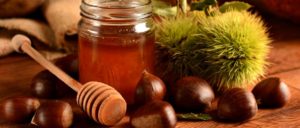
Chronic gastritis is treated with food, honey, and a prescribed diet. The course of treatment for diseases of the stomach and intestines should be 2-3 months.
The following recipes have proven themselves well:
- 10 aloe leaves are kept for 5-7 days in the refrigerator, after which they are crushed in a blender or meat grinder. The resulting mushy mass is mixed with honey in a ratio of 1: 1 and taken on an empty stomach in the morning. Dosage: 1 tbsp. l. per day.
- 2 tsp dry chamomile pour 1 tbsp. boiling water and insist for 20 minutes. When the solution has cooled slightly, add 1 tsp to it. honey. The resulting broth is drunk half an hour before meals 1-2 times a day.
With urolithiasis
The healing properties of chestnut honey can effectively relieve inflammation in the kidneys and remove the sand resulting from softening stones. This requires 1 tbsp. place the substances in a jar and put it in a water bath. Then add 1 tbsp to honey. l. chopped calamus root and stir thoroughly. The resulting mixture is slightly cooled, after which it is ready for use.
Dosage of the medicinal product: 3-4 tsp. 1 time per day before meals.
With kidney disease
The benefits of chestnut honey are fully manifested in the treatment of kidney diseases in combination with medicinal herbs and juices:
- A mixture of chestnut honey and rose hips gives excellent results. To do this, 500 ml of rosehip broth is diluted with 15 g of honey.
- Rosehip from the recipe above can be replaced with 200 ml of radish juice.
- A mixture of honey, olive oil and lemon juice, taken in equal parts, removes sand from the kidneys well.
With varicose veins
Venous varicose veins are treated with honey compresses. To do this, the fabric is impregnated with honey and applied to sore spots, attaching with PVC film and bandages. Treatment takes place in 3 stages:
- 1st day the compress is kept for 2 hours;
- the next 2 days - 4 hours;
- 4th day - from 12 pm to morning.
To improve potency
Chestnut honey is the best aphrodisiac of all varieties and a natural anti-inflammatory agent. Useful properties of the product help to maintain male potency. To do this, you need to consume the product in its pure form, 1-2 tbsp. l. a day and drink honey with milk or tea.
Also, good results are obtained by using a mixture of chestnut honey and walnuts. Proportions: 100 g of nuts and 1 tbsp. l. substances. Dosage: 1 tbsp. l. 2-3 hours before bedtime. The first results will be visible in 5-7 days.
For more information on how to improve potency, see the video below:
For eye treatment
The benefits of chestnut honey in treating the eyes are best revealed in decoctions and tampons.
Decoction recipe:
- Dried blueberry leaves are crushed and poured into 1 liter of boiled water.
- Add 200 g of honey to the mixture when the water cools down a little.
- The resulting solution is removed for a day in a dry, dark place, after which the broth is ready for use.
Dosage: 1 tbsp. 2 times a day.
Inflammation of the eyelids and cornea is removed using tampons soaked in honey.
For quick healing of wounds and burns
The beneficial properties of the product include anti-inflammatory effects, so the product is used to heal abscesses, scratches, wounds and ulcers.
Healing ointment recipe:
- Honey and flour are mixed in a 1: 1 ratio.
- The mixture is diluted with warm water.
- The resulting dough is kneaded and applied to the affected skin area.
You can also make a fish oil mixture. To do this, take 80 g of chestnut honey, 20 g of fish oil and dilute the resulting mass with 2 g of "Xeroform". A mixture of honey and sea buckthorn oil, which must be mixed in a 2: 1 ratio, is no less beneficial in the treatment of wounds and ulcers.
The use of chestnut honey in cosmetology
The beneficial properties of chestnut honey in cosmetology are revealed through nourishing masks for the skin and hair. The product not only promotes healing of minor lesions, but also improves the overall condition of the skin, making it silky and healthy in color. In addition, the substances contained in honey strengthen the hair structure.
For facial skin
Face mask recipes:
- For dry skin, mix 1 tsp. honey, a slice of banana and 1 tsp. cream 10% fat. The mask is applied for half an hour, after which it is washed off with warm water.
- For oily skin and elimination of fine wrinkles, use a mixture of 1 tsp. chestnut honey with 1 tsp. starch. All this is diluted with a little milk and salt. The gruel is thoroughly mixed and applied to the face for 20 minutes, after which it is washed off with warm water.
For the beauty and health of hair
A strengthening hair mask is prepared as follows:
- The onion is finely grated and poured into a saucer.
- Onion chips are poured with 5 tbsp. l. product and stir thoroughly.
The mask is applied to the hair for half an hour. Then the mixture is washed off with shampoo.
Harm of chestnut honey and contraindications
Like any waste product of bees, chestnut honey has, in addition to a number of medicinal properties, a list of contraindications. Excessive consumption of chestnut honey is more harmful to human health than beneficial:
- The product can cause severe allergic reactions, therefore, special care should be taken when allergic to pollen and nectar.
- People with diabetes are also advised to strictly adhere to the daily intake.
- The product may harm the health of nursing and pregnant women.
Otherwise, chestnut honey has no contraindications. Possible harm is caused only by the excess content of the product in the diet.
The following symptoms indicate an allergic reaction:
- nausea;
- rash;
- itching;
- stomach upset;
- swelling of the mucous membrane;
- Strong headache;
- runny nose.
At the first sign of allergy, you should stop taking honey-based medications to avoid more harm.
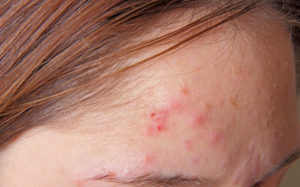
How to choose natural chestnut honey
The most important thing when choosing a product is to try it so as not to buy a fake, which is not only useless, but can also cause serious harm to health. The quality of a substance is mainly determined by taste and smell, and only then by its appearance and consistency. A natural product is distinguished from a fake by the following characteristics:
- Honey smells nice of pollen and chestnuts, but the smell cannot be called too intense. It is light, airy.
- The real product tastes slightly bitter. After the test, the throat "tears" a little.
- When tasting, there should be no burnt sugar flavor. This is the first sign of a fake - to give ordinary honey a chestnut look, burnt sugar is added to it, which darkens the substance.
- The color of the natural product is dark. It acquires this color due to the high content of enzymes and chestnut pollen. The dark tone is the reason why the variety is often confused with buckwheat.
- The cost of chestnut honey is more expensive than other types. This is because chestnut is a thermophilic plant that grows only in the south of the country.
- In August, chestnut honey is quite runny. After 2-3 months, it crystallizes and thickens. If in the summer the product is already presented in the form of a thick mass, it is either a fake or last year's product, which, instead of benefit, will bring harm to the body.
- Falsification is evidenced by the stratification of the product in summer and the presence of blotches of a different color.
- Real chestnut honey doesn't drain off the spoon too quickly, but it wraps around it easily.
- In natural products, particles of pollen are noticeable. A product that is too pure is likely to be counterfeit and will only result in harm instead of benefit.
It is best to buy chestnut honey from trusted sellers who will not deceive regular customers and dilute the product with juices, syrup and other liquids. It is also difficult to stumble upon a fake, at fairs and exhibitions where everyone is trying products, it is very difficult and risky to deceive buyers.
How to store chestnut honey at home
In order to preserve all the medicinal properties of chestnut honey, it must be stored according to certain rules:
- Do not keep it in a high temperature room and place it too close to the stove or microwave. Also, do not place a container with a product on the windowsill - direct sunlight will inevitably heat it up.
- Excessively low temperatures also strongly affect the preservation of the beneficial properties of chestnut honey. Do not store it in the refrigerator, and even more so in the freezer - this will cause instant crystallization of the product.
- The optimum storage temperature is from + 5 ° C to + 20 ° C. With this temperature regime, the benefits of the substance will be fully preserved, and the healing properties will not turn into harm.
A tight-fitting lid is especially important. If the product is not sealed, it will deteriorate and subsequently only harm health.
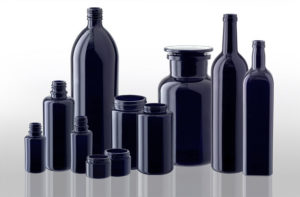
Conclusion
Useful properties and contraindications of chestnut honey are explained by the unusually rich chemical composition and nature of the product.It is made from the nectar of various chestnut fruits, which act as strong allergens. That is why you should be careful when taking chestnut honey, as it can bring not only benefits, but also harm. Despite the fact that the main purpose of the product is the treatment and prevention of colds and problems of the genitourinary system, it also helps with stress and insomnia, calming the human nervous system. The most important thing is to comply with the consumption norms for diabetes and choose high-quality honey.

